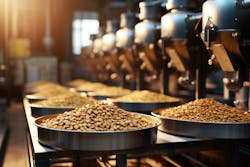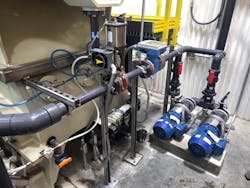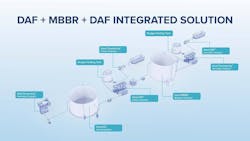Many of us rely on pet food manufacturers to provide high-quality and nutritious food products that keep our pets happy and healthy. As part of this process, pet food manufacturing facilities must render and blend animal proteins, vegetables, grains and other organic ingredients to produce wholesome, well-balanced wet and dry food products. In doing so, however, pet food manufacturing plants inevitably generate wastewater with high levels of contaminants. These compounds include total suspended solids (TSS), organic compounds (BOD/COD), ammonia (NH3-N) compounds, and fats, oils and grease (FOG) — all of which can significantly impact ecosystems and public health if not properly treated.
Given these factors, developing an effective solution to treat wastewater prior to its reintroduction to the environment is critical. At the same time, it is not always a clear-cut process, requiring the right combination of physical, chemical and biological processes rather than a one-size-fits-all solution.
To help select the best wastewater treatment plan for pet food manufacturing applications — whether to meet local pretreatment regulations or promote more sustainable treatment practices — this article provides a helpful overview of the types of contaminants encountered and describes the different solutions available to ensure pet food manufacturers achieve required effluent regulations. It will also explore integrated wastewater technologies that not only effectively remove the contaminants, but also offer cost, energy and performance advantages.
The role of water in pet food applications
Pet food manufacturing facilities require water for many operations on the production side. For example, water is used to mix and combine ingredients to create the proper consistency, as well as in the baking processes. Water also plays a role in sanitation for cleaning equipment, machinery and production areas, preventing contamination.
The wastewater generated from these and other processes must be properly treated to comply with increasingly stringent environmental regulations. Effluent regulations, for example, limit the amount of pollutants — including biochemical oxygen demand (BOD), TSS, ammonia, total nitrogen and phosphorus — that are discharged to a privately owned treatment works (POTW) or directly into bodies of water in order to prevent contaminants from harming aquatic life and degrading water quality. Treating wastewater from these applications also prevents the spread of harmful pathogens.
It is important to be familiar with the specific contaminants present within pet food wastewater — and the technologies that offer solutions to these challenges — in order to design the optimal treatment solution. What follows is an overview of common treatment methods that may be used in pet food wastewater treatment.
Physical separation methods
Physical separation methods are the first step in treating pet food manufacturing wastewater — specifically, removing FOG, TSS and particulate BOD/COD. This method is a simple and cost-effective way to remove a large portion of these pollutants. A dissolved air flotation (DAF) system — one such separation technology — removes FOG, TSS and non-soluble organics by dissolving pressurized air into water and forming tiny microbubbles. As these bubbles enter the flotation zone located within the DAF system, contaminant particles attach to the bubbles, lowering the particle density and causing the FOG, TSS and other non-soluble organics to separate from the wastewater and rise to the surface. The top surface layer of separated contaminants is then skimmed and collected into a sludge hopper.
Biological solution methods
In addition to FOG, TSS and non-soluble organic compounds, the wastewater in pet food manufacturing plants contains high levels of soluble biological contaminations like BOD/COD, ammonia-nitrogen (NH3-N) and phosphorus (PO4-P).
In order to meet effluent limits for these soluble parameters, one popular treatment method — known as the activated sludge process — uses bacteria to treat the pollutants contained in the wastewater. These microorganisms consume organic matter, nutrients and other contaminants within the wastewater, producing carbon dioxide, water and biomass as they grow. The digested wastewater flows to a secondary clarifier for sedimentation of the bacteria, which then return to the head of the aeration tank while the clarified water is discharged.
Another biological treatment method to reduce soluble parameters uses a moving bed biofilm reactor (MBBR) process, which is a fixed-film system that reduces BOD and enables nitrification and denitrification. This technology relies on specially designed bio-media within the MBBR tank that enables bacterial growth. These biofilms digest the organic matter in the wastewater and convert soluble material into biomass that can be removed downstream. Near the top of the tank, a stainless steel sieve allows water to exit the reactor while preventing the bio-media from escaping. Compared to conventional activated sludge systems, MBBR is a flow-through system that reduces operator attention. It also reduces the equipment footprint due to its high effective surface area provided by the specially designed bio-media in the system.
Phosphorus removal methods
Finally, if phosphorus must be removed from the pet food manufacturing wastewater before it is released into the environment, adding coagulants to the wastewater to precipitate the phosphate is a solution. Similar to the removal of suspended solids using DAF technology's physical-chemical processes, phosphorus removal relies on ferric chloride or polyaluminum chloride (PAC). These coagulants precipitate the phosphorus, and then a DAF system is used to remove the generated solids.
Achieving success
The key to success for pet food manufacturing plants to comply with regulations, meet business targets, reduce treatment costs and minimize their environmental impact is identifying the required wastewater removal methods to meet effluent limits. These factors, in turn, will inform the design of an effective wastewater treatment solution.
Chandler Johnson is chief technology officer at World Water Works, Inc.
World Water Works





